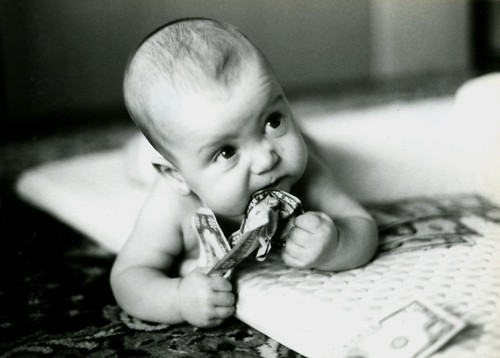- The Festival of Frugality #278 The Pure Peer Pressure Edition is up. All of your friends are reading it. http://bit.ly/aqkn4K #
- RT @princewally: Happy StarWars Day!: princewally's world http://goo.gl/fb/rLWAA #
- Money Hacks Carnival #114 – Hollywood Edition http://bit.ly/dxU86w (via @nerdwallet) #
- I am the #1 google hit for "charisma weee". Awesome. #
Meal Plans
- Image by Getty Images via @daylife
When we don’t have a meal plan, food costs more.
Our regular plan is to build a menu for the week and go to the grocery store on Sunday. This allows planning, instead of scrambling for a a meal after work each night. It also give us a chance to plan for leftovers so we have something to eat for lunch at work.
We work until about 5 every weekday. When we don’t have the meal planned, it’s usually chicken nuggets or hamburger helper for dinner. Not only is that repetitive, but it’s not terribly healthy. It is, however, convenient. If we plan for it, we can get the ingredients ready the night before and know what we are doing when we get home, instead of trying to think about it after a long day of work.
If we don’t plan for leftovers, we tend to make the right amount of food for the family. When this happens, there’s nothing to bring to work the next day, which means I’ll be hungry about lunchtime with nothing I can do about it except buy something. Buying lunch is never cheaper than making it. I can get a sandwich at Subway for $5, but I could make a sandwich just as tasty and filling for less than half of that, using money that is meant to be used for food. All during wrestling season, we make 30-inch sandwiches on meet nights for a cost of about $5, feeding ourselves and at least a couple of others who didn’t have time to make their dinner before the 5:30 meet.
No leftovers also means no Free Soup, which is a wonderful low-maintenance meal that leaves everybody full. Nobody ever gets bored of Free Soup. (Hint: Don’t ever put a piece of fish in the Free Soup, or the flavor will take over the entire meal.)
Unhealthy, repetitive food for dinner. Over-priced, low-to-middle-quality food for lunch.
OR
We plan our meals right and have inexpensive, healthy food that doesn’t get boring for every meal.
It seems to be a no-brainer. Except, I don’t have lunch today because we didn’t plan our meals and used the last of the leftover hamburger helper for dinner last night.
Update: This post has been included in the Carnival of Personal Finance.
Beat the Check

- Image via Wikipedia
Have you ever played a game of “Beat the Check”? Your rent is due tomorrow, but you don’t get paid until Friday, so you write the check today an, on payday, you run to the bank to get your paycheck deposited before it has a chance to clear. To stretch out the time, you write yourself a check from another account to cover the deficit, knowing that will take a few more days to clear. This is called “floating” a check.
Sound familiar?
I think most people who write checks have tried to rush a deposit in before a check clears.
In 2004, the Check 21 act went into effect, which turned the game on its head. This law gave check recipients an option to make a digital copy of a check, slashing processing time. Instead of boxes of checks being transported around the country, the check began getting scanned and instantly transferred, along with all of the encoding necessary to keep the digital checks organized. This dramatically cut the amount of time it took to clear a check. What was once a week was reduced to as little as 48 hours.
Now, as technology improves and banks update their infrastructure to match, the “float” time has been reduced even further. Many banks are using image control systems to instantly convert all incoming checks to digital format. Within a couple of hours, these images can be transmitted to the Federal Reserve, to be transmitted nearly instantly to the issuing bank. If both the issuing and the receiving banks are using modern image control systems, it is impossible to float a check. “Beat the Check” is a thing of the past. It’s like betting on purple at the roulette wheel.
Of course, this doesn’t mean that the funds are instantly available. That would eliminate the banks being able make use of the funds during that time. Don’t expect the banks to make a habit of allowing you the use of your money before the federal regulations demand it.
Twitter Weekly Updates for 2010-07-17
- RT @mymoneyshrugged: The government breaks your leg, and hands you a crutch saying "see without me, you couldn't walk." #
- @bargainr What weeks do you need a FoF host for? in reply to bargainr #
- Awesome tagline: The coolest you'll look pooping your pants. Yay, @Huggies! #
- A textbook is not the real world. Not all business management professors understand marketing. #
- RT @thegoodhuman: Walden on work "spending best part of one's life earning money in order to enjoy (cont) http://tl.gd/2gugo6 #
Cheap Drugs – How I Saved $25 in 3 Minutes

- Image by cackhanded via Flickr
Today, I stopped by the grocery store to pick up a couple of prescriptions. I always get the generics, because they are less than half the price of the name-brands, while still being chemically identical. That’s not what I’m talking about, although it did save me about $75 today.
When the pharmacist rang up my medications, the total came up to $35. That just wasn’t right.
Many chain pharmacies have gone to a cheap pricing model for generic drugs. That usually means $4-6 per monthly prescription. Cub Foods doesn’t have that.
So I asked for the price match.
Cub Foods matches prices on generics with whatever large pharmacy is nearby. In this case, they matched Target’s prices, bringing the price from $35 to $10. Instant $25 savings. I just had to wait for them to look up my prescriptions in their match-book.
Pharmacies with cheap generics:
K-Mart offers a 3 month supply for $15.
Target and Wal-Mart both have a 30-day supply for $4.
Publix offers a 14-day prescription for some antibiotics for free. That’s insane! It’s also a heckuva way to get people in the door. “Why don’t you shop for half an hour while I fill your scrip?”
If your pharmacy is anywhere near any of these stores, call and ask if they’ll match the price for generic drugs.
A few tips:
Before you go get your cheap drugs, call ahead and make sure what you need is on the cheap list. Don’t assume.
You won’t be able to use your insurance to buy the cheap generics. The overhead in insurance processing would mean that the pharmacies would be operating at a loss for each prescription. You can’t make that up in volume. Between our copays and deductibles, it’s far cheaper to just pay the generic price without involving the insurance company.
Don’t be afraid of generics. It’s not like Nike. Generics are chemically identical to the name brands. There are two differences: the price and the letter stamped on the side of the pill.
The stores offering cheap drugs are generally bigger stores hoping to use the drugs as a loss leader. Places like Walgreens or CVS make up to 70% of their profits from the pharmacy. They can’t stay open treating that as a loss leader.
How do you save money on prescriptions?
Babies Are Expensive
From the comments here. The discussion is on how much it costs to have a baby. Edited for clarity.
 Babies” width=”270″ height=”200″ />
Babies” width=”270″ height=”200″ />
Actual birthing costs vary. We’ve had three kids over ten years and birthing costs have varied from $250 out of pocket to $8500. Our highest and lowest price births were 20 months apart. The highest price birth involved induced labor with an epidural. For the lowest out-of-pocket price, I added my wife to my policy before the birth, so she was double-covered. If one of your policies is less than ideal and there are multiple policies available, I recommend doing this. It saved us thousands. All told, If things go well, you could slide for as little as $1500 total.
For the highest price birth, we threw ourselves on the mercy of the finance department. They have a charity fund to pay the bills of the less fortunate. We qualified…barely. If you have a medical bill you can’t afford, ask if there is a grant or donation you can apply for. Always ask if there is some way the bill could be lowered.
Breast-feeding beats the heck out of formula, financially, but breast-feeding doesn’t always work. Ignore the boob-nazis who insist you are slowly killing your kid by using formula. I’ve got 3 kids, and each had different feeding issues.
Baby formula runs $19 for a big container at Sam’s Club, or a large percentage of your soul at most other big box stores. Formula alone will pay for your membership in under a month. For a big eater, that’s $20-30 per week. For a normal eater, 2-3 weeks. For planning purposes, assume $100/month in formula costs for the first six months, when food starts coming into play heavily. After that, the formula expense goes down, but not away for at least 6 more months.
Diapers are painful. Not just the smell–though that hurts, too, sometimes–but the expense. I currently have 2 in diapers; one is potty-training. Our monthly costs for diapers, now, are about $75. It was easily twice that when they were younger. Figure at least $100 per month in diapers. Unless your baby has irritation problems, go with cheap diapers. Leak-guard is a joke. If you are relying on leak-guard to keep the contents inside the diaper, you aren’t changing your baby often enough.
I couldn’t begin to guess at how much you’ll spend on baby clothes. I have never bought clothes for our kids. Whatever didn’t come free from friends and family walked into the house of it’s own volition, following my wife home from the store.
Toys are an almost purely voluntary expense. You’ll get as much as the kids needs free, as presents. You’ll go overboard and give the kids 10 times that, without realizing it. Don’t. For the first four to five months, its fingers and toes will be entertaining enough. After that, if there are more than about ten toys, it’s too many; the kid will never get attached to any of them. Keep it small. It’s better for the kids and the budget. Little kids prefer boxes to toys, anyway. Give the kid a shoebox instead of a Leapfrog. Really.
Portraits suck, too. If you have to get them done professionally, get a membership that covers sitting fees, and use coupons. I recommend JC Penney’s. Using judicious coupons and the membership, we get portraits for under $20.
Baby food is probably cheaper to make in a food processor, but you can’t beat the convenience of the little jars. If you watch sales, you can stock up affordably. Mix every meal with some rice or oatmeal mush to stretch it, without making it unhealthy. Depending on your kids, and how much you listen to the “experts”, this is a nonexistent expense before six months. Our kids started eating baby food in their second months, at least a little bit.
Babies are expensive. Don’t doubt that for a second, but ignore the polled averages when it comes to expense. Hand-me-downs, thrift stores, and good sales cut the expense a lot.
How do you save money and value with a baby in the house?